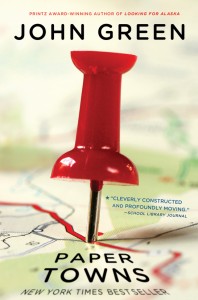 “Paper towns” in John Green’s 2008 novel of the same name are places that exist on paper but not in real life. The story takes Quentin, at the moment of his high school graduation, to many paper towns in the Orlando area and finally to a fake town on a map in New York State in search of Margo, his next door neighbour and unrequited love. The paper towns in Florida are failed suburban subdivisions that live as plans on paper and are even shown on local maps.
“Paper towns” in John Green’s 2008 novel of the same name are places that exist on paper but not in real life. The story takes Quentin, at the moment of his high school graduation, to many paper towns in the Orlando area and finally to a fake town on a map in New York State in search of Margo, his next door neighbour and unrequited love. The paper towns in Florida are failed suburban subdivisions that live as plans on paper and are even shown on local maps.
I have a slide entitled “Paper City” in one of my powerpoint presentations that I use to teach planning students. The idea is that to fully understand city landscapes, one has to be aware of the paper city, which is contained in planning studies, policies of local councils, and approved development applications. In Ontario, every municipality (city, township, county) has a comprehensive plan with a map showing the area of that municipality in terms of its land use (residential, retail, employment, open space and parks) and that map is a combination of the “real” lived material landscape of buildings, roads, and trees we see and experience every day along with an imagined future for that same landscape–the paper city. The imagined paper city in a comprehensive plan is aspirational, a better place. Property owners who wish to make changes to the use of their land have to look at that map and see how their plans fit with the planned future city. As planners, the paper city sometimes seems as real as the real city.
A friend of mine was looking out over the rooftops of Toronto with me. It was a long view all the way across the leafy neighbourhoods, condos and office buildings. He commented on how random the placement of tall buildings was and how weirdly dispersed everything seemed to him. I realized that my same view included my mental map of the paper city from reading dozens of reports and looking at dozens of maps over the years. The paper city in my head overlaid the material city in my view and the result was not random at all.
I enjoyed reading Paper Towns because Green gets the connection between the places the characters inhabit and their identities. Margo’s character is a paper girl because she sees her better self in terms of her aspirational self, the plans for whom she writes in her moleskin journal. But, in the story, she runs away from the real world to a fictitious place invented by a cartographer because she understands that “The people are the place is the people” (291). For her to comfortably inhabit her real world, the suburbs of Orlando, her parents and her high school clique would have to change. Instead she inhabits an aspirational world, where she spends her time plotting out a better world, where, like an urban planner, if you can change the place, you can change the people.
Beware planning students:
YOU WILL GO TO THE PAPER TOWNS
AND YOU WILL NEVER COME BACK (149)
